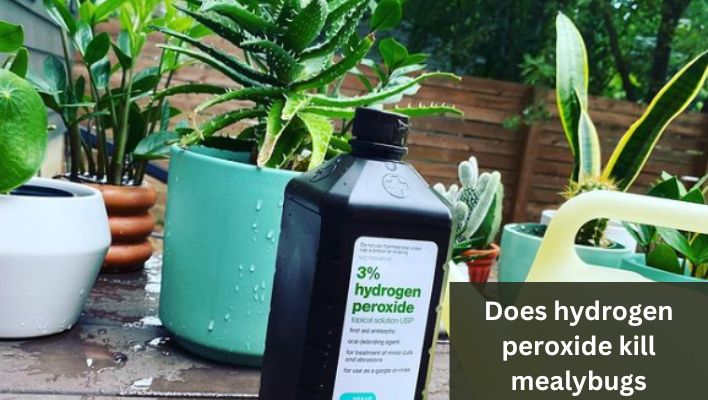Hydrogen peroxide (H 2 O 2) is a common household cleaner used to disinfect or treat cuts or burns. But did you know it can also kill mealybugs?
Hydrogen peroxide is an oxygen-based substance that can kill dander and dirt. It also works to remove mold and mildew as well as kill existing mealybugs. It is an alternative to other pest control methods like pesticides and sprays.
One of the most annoying pests in lawns is the mealybug. They can be found on all lawns, including turf, ornamental gardens, and plants and trees. Although these pests may not cause any visible signs of damage, they will still leave their mark on your lawn by decreasing its quality and health.
Hydrogen peroxide can kill mealybugs, but it’s not good in larger quantities. Here’s everything you need to know about hydrogen peroxide and how it works against mealybugs.
What is hydrogen peroxide?
Hydrogen peroxide (H2O2) is a chemical compound that can dissolve hydrogen gas in water. It has the chemical formula H₂O₂, and it’s a strong oxidizer.
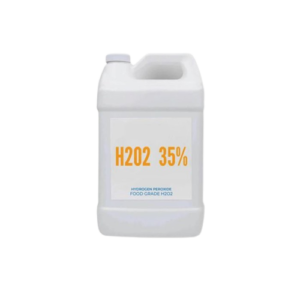
It is a substance with two oxygen atoms bonded to an electric charge, making it an acidic compound. It’s highly reactive and can be found in many household products, including bleach, antiseptic wipes, and hair dye.
Hydrogen peroxide is used to bleach stains from laundry and household surfaces, treat wounds and sterilize medical equipment. It’s also used for swimming pool sanitation and as a disinfectant for the home.
It has long been used to treat plants in agriculture. However, you should always dilute hydrogen peroxide with water before using it on your plants so that you don’t harm them.
Can you use hydrogen peroxide on plants?
You might be wondering if hydrogen peroxide can be used on plants. Hydrogen peroxide isn’t just for cleaning; it’s a great way to fight off common pests, like scale and mealy bugs. It also kills a lot of disease-causing organisms, including fungi and bacteria.
Hydrogen peroxide is a natural plant food that can cleanse leaves and prevent diseases in your garden. So, you can use hydrogen peroxide on plants.
It breaks down organic matter and kills germs, so it’s great for keeping your garden pests free. However, It can burn and leave your green thumbs looking like a bad acid attack. But all is not lost for those who still want to try it. When it comes to using hydrogen peroxide on plants, there are two main things to keep in mind:
- Don’t use hydrogen peroxide on plants actively growing or flowering plants because they will absorb more chemicals than other plants.
- Keep in mind that hydrogen peroxide is not an ideal solution for all plant problems; it can damage leaves if it’s used too much or too often.
Ensure to dilute it before applying it to the leaves of your plants, as too much hydrogen peroxide will burn your plant. The best way to do this is by adding one part of hydrogen peroxide to four parts of water.
Also, make sure to rinse any excess hydrogen peroxide off of the leaves when you’re done so that you don’t create an unhealthy environment for the plant.
The most important thing to remember when using hydrogen peroxide on plants is that it isn’t intended for this purpose. It should be used only as a disinfectant or cleaner, not as plant food or pesticide.
- READY TO USE - These convenient granules are ready for use and provide effective, long lasting insect control for up to 8 weeks in your flower beds, roses, and shrubs. Apply it every 8 weeks throughout the growing season for optimal protection.
- PEST CONTROL - Bonide Systemic Granules kill tough houseplant pests like fungus, gnats, mealybug, whitefly, termite, aphids, and more.
- NO SPRAYING - There is no mess associated with this pesticide because it is not a spray. The dry-application granules are easy to use, control, and apply without worrying about destroying clothing or other plants.
Benefits of hydrogen peroxide on plants
Hydrogen peroxide is important to many plants’ growth, health, and immunity. It has been found to increase the number of seeds germinating and the speed at which the seeds grow into plants. It can also help with disease prevention, as it has been shown to kill bacteria in the soil.
In addition, hydrogen peroxide can be used as an antifungal agent when applied to plant roots or leaves. This makes it a great choice for indoor plants since it can help prevent fungus from spreading throughout your home.
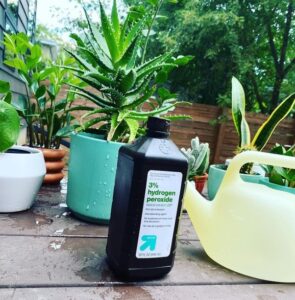
Here are some of the benefits of hydrogen peroxide on plants:
- It helps to increase photosynthesis and respiration, which can improve plant growth
- It can reduce disease by killing bacteria and fungus
- It also kills mold and mildew by interrupting their growth cycle.
- It can increase nutrient uptake by plants
- Also, it helps with soil management and fertilizer application.
- It boosts energy for your plants by helping them fight off disease and keep their leaves clean.
If you plan on using hydrogen peroxide as a fertilizer, be sure to dilute it with water before applying it to your plants. You can add one teaspoon of hydrogen peroxide for every gallon of water that you use for dilution.
How to use hydrogen peroxide to kill mealybugs
However, if you have decided to use hydrogen peroxide to kill pests like mealybugs in your garden, you can use the methods below. If you have mealybugs, they can be a pain in the butt. They are often found on plants and cause damage to the plant’s leaves, stems, or roots.
You can kill mealybugs with hydrogen peroxide. The best way to use hydrogen peroxide for this purpose is by mixing it with water in a spray bottle. You should then spray the mealybug-infested area with the solution.
Here’s how:
- Mix 2 tablespoons of hydrogen peroxide with 1 quart of water and make sure it is completely mixed. Or One part of hydrogen peroxide with ten parts of water
- Spray the solution onto the plant, or pour it directly on the mealybugs.
- Let the plant or bugs dry out before watering again.
- Spray your plants with this solution at least once every week.
Hydrogen peroxide can kill plants.
It is a common misconception that hydrogen peroxide will not harm plants, but this is false. Hydrogen peroxide is an oxidizer, which means it can remove oxygen from the molecules of plant cells. This can kill the plant if the concentration is high enough or the exposure time is long enough.
Hydrogen peroxide can be used as an alternative to bleach on many surfaces, but it should never be used on plants without being diluted because it can kill them.
It can kill weeds, mildew, mold, and algae. Hydrogen peroxide can damage plant leaves, roots, stems, flowers, and seeds. The damage can be permanent if you use too much or at the wrong time for your plant.
However, hydrogen peroxide will also help keep your plants healthy if you have a mildew problem when you use it rightly.
When diluted with water, however, hydrogen peroxide won’t affect a plant’s health at all, and it has been shown to positively affect plant growth. So you should use it cautiously when using hydrogen peroxide on your plants.
However, It will not kill plants when diluted; it does not have any residual effects on plants once it has been washed away. However, some forms of hydrogen peroxide may still be present in the environment after being washed away from the surface (such as when it reacts with other substances).
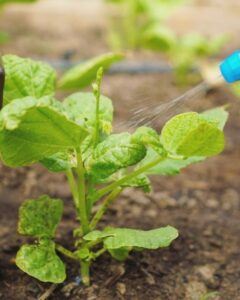
How much hydrogen peroxide to add to water for plants
The amount of hydrogen peroxide you add to water for plants depends on the type of plant you’re growing and how much sunlight your plant receives. Whether using it to eliminate pests or fertilize plants, it is crucial to dilute hydrogen peroxide and do it rightly.
Hydrogen peroxide is an oxidizing agent that can break down harmful substances in the soil or water. It is also an antiseptic, which can help fight off infections caused by bacteria and fungus.
There are different types of hydrogen peroxide, such as 3%, 5%, or 35% concentration. The 3% hydrogen peroxide has a normal concentration of hydrogen peroxide compared with the other types. The 5% type is meant for external use on the skin but not internal use on the skin or mucous membranes (e.g., eyes).
You can buy liquid and powdered forms at any grocery store or home store selling gardening supplies or pest control products.
Here’s how much hydrogen peroxide you should add:
To use hydrogen peroxide as a plant fertilizer, add one part to 10 parts water (1 part H2O2 = 10 parts water).
- For every gallon of water, you’ll want to add 1/2 cup of hydrogen peroxide
- Or 1 cup of water to 1 and 1/2 teaspoons of 3% hydrogen peroxide
How often can you use hydrogen peroxide on plants?
Hydrogen peroxide is a great way to care for your plants and keep them looking beautiful. It’s safe and non-toxic. However, it has a high hydrogen peroxide concentration, so you should use it sparingly.
Hydrogen Peroxide can be used on many plants, including houseplants, lawns, and even trees. You can use it as a liquid or an aerosol spray; the choice is yours. It is recommended to start with once every week until you’ve gotten a feel for how often they need their weekly dose of Hydrogen Peroxide.
If you’re using it on plants, use it sparingly, which is enough to do the job but not so much that you’re hurting your plant or its environment. It can be toxic if used incorrectly or at too high a concentration.

Other use of hydrogen peroxide in the garden
Hydrogen peroxide is a great tool for the garden. It can kill off pests, repel insects, and keep pesky weeds at bay.
Hydrogen peroxide can be used in the garden to help your plants grow. It’s a natural disinfectant, killing bacteria and fungus on contact. You can also use it to treat root rot, which is caused by an overgrowth of bacteria in the root zone of plants. It doesn’t work as well on fungal problems, but it’s still worth trying!
- Using hydrogen peroxide as a pesticide, mix it with water in a spray bottle, and spray it on plants you want to kill.
- Kill weeds with hydrogen peroxide: Sprinkle it around your plants so that it seeps into the soil, where it will kill off any weeds that have managed to germinate.
- Prevent root rot in your potatoes or carrots.
- Use hydrogen peroxide as a fungicide by mixing 2 parts of water and 1 part of hydrogen peroxide before spraying on your plants. This will help keep fungus from spreading throughout your garden.
Other natural ways to get rid of mealybugs
Mealybugs are tiny insects that live in your home. And they’re a real pain. They’ve also been known to cause allergic reactions in some people, so if you have allergies, you might want to avoid this treatment method.
The good news is that there are many other ways to get rid of mealybugs without toxic chemicals. You just need some household supplies to restore the health of your plants.
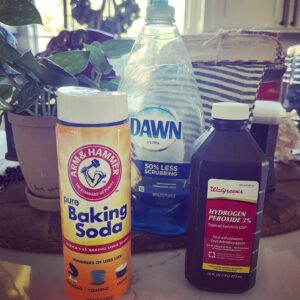
Baking soda works
You can use baking soda to get rid of mealybugs in your home. The baking soda will kill the mealybugs, but it’ll also kill any other critters living in those same spots—if you’d like, you can use the same method on any other creepy crawlies.
Mix 1/4 cup baking soda with 1/4 cup water and sprinkle it around the areas where you have noticed mealybugs. Let it sit for two days, and then vacuum up the powdery remains.
You can also spray your plants with water mixed with a few tablespoons of lemon juice once or twice per week to help keep the bugs away.
Use cinnamon oil
Cinnamon oil is a great all-natural way to get rid of mealybugs. You can buy cinnamon oil at most grocery stores or make your own by mixing cinnamon sticks with water and letting it sit in the sun for several days.
Once the mixture has dried, you can spray the mealybug infestation on the plants’ leaves. The best part about this method is that it works faster than any chemical spray would—it’s even safe for your pets!
Use Neem oil
Neem oil is a great option to get rid of mealybugs. Not only will the oil kill the mealybugs, but it will also be able to discourage them from returning.
To use neem oil, mix one teaspoon in a quartz of water and spray it onto your plants. It will act as an insecticide and fungicide, killing both adult and larva mealybugs.
You can also make neem oil into a spray by mixing it with water in a spray bottle. Then, spray both sides of your plants with this mixture every other day for two weeks to eliminate any remaining mealybugs.
diatomaceous earth
Diatomaceous earth is an all-natural way to eliminate these pests without using chemicals or pesticides. It’s made from fossilized diatoms, which is how it got its name—and it’s very effective at getting rid of these pests. Diatomaceous earth contains tiny bits of silica that can kill pests like aphids, mealybugs, and other soft-bodied insects.
You can sprinkle it around your home or garden, but be careful not to use it on plants or places where children might play, like on a patio. Diatomaceous earth is safe for people and pets if used properly, but make sure you wear gloves when using it outside.
Applying diatomaceous earth to your plant leaves and flowers will actually break down the outer coating of the mealybug, so it’s easier for the plant’s natural defenses to kill it off. It may take a few applications before you see results, but once you do, the mealybugs will go away for good.
Epsom salt
Epsom salt is a natural home remedy that can help to get rid of mealybugs. The best way to use Epsom salt is to sprinkle it on the surface where you see the mealybugs. Alternatively, you can mix Epsom salt with water to make a spray.
You can mix one part of Epsom salt with four parts of water and allow it to sit on your plants for several hours or until it has absorbed into the soil. This will help kill any surface mealybugs that are present in your plants.
The solution will kill the pests and start the process of drying them out, which will eventually cause their death. You should repeat this process every day for about three days until all the mealybugs are gone.
Use Dish soap
There are many ways to get rid of mealybugs, but one of the easiest is to use dish soap with water. Mix a tablespoon of dish soap with one cup of water and spray it on the affected area. The soap will kill the mealybugs, and they will fall off the plant!
Use rubbing alcohol.
Rubbing alcohol contains high levels of acetic acid (vinegar-like chemical). This chemical is toxic to insects and works well as an insecticide. This is a safe way to kill pests without harming the plant itself.
Mix 1/4 cup (60 ml) of rubbing alcohol into a spray bottle and spray it all over your plants. You may need to repeat this process two or three times for the best results.
If there are too many bugs for you to kill with one application of rubbing alcohol, repeat this step so that you can keep killing them off until no more show up
Cayenne Pepper Solution
Cayenne pepper is an effective way to get rid of mealybugs, but it’s not recommended for use around plants or young children. While some people have reported success with this method, others have gotten severe burns on the skin from using cayenne pepper as a pesticide.
If you decide to try this method, wear rubber gloves and eye protection. Mix 1/4 tsp cayenne pepper with 1 cup water in a spray bottle and spray the mixture onto infested plants. Leave it on for 30 minutes before rinsing it off with water. Repeat every two days until the mealybugs are gone.
Garlic spray
You may be thinking, “Garlic spray? That sounds gross.” But this method works! To make your own, take two tablespoons of minced garlic, two cups of water, and one tablespoon of dish soap.
Mix the ingredients in a spray bottle and shake until everything is combined well. Store this mixture in an old spice jar with a lid that fits snugly on top. If you want to store it for longer than that, you can put it in the refrigerator.
If you want to use commercially branded garlic spray instead, just mix one tablespoon of minced garlic with two tablespoons of water in a spray bottle and shake until everything is combined well. Keep out of direct sunlight.
